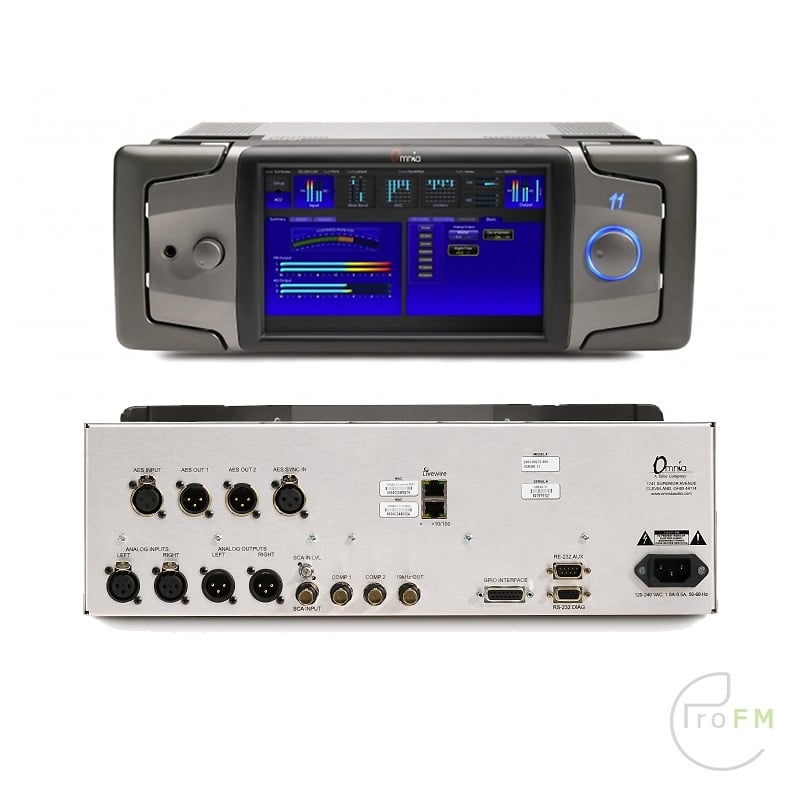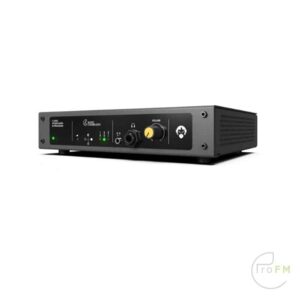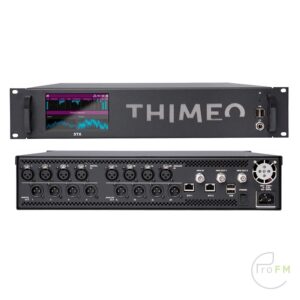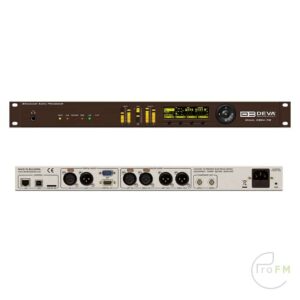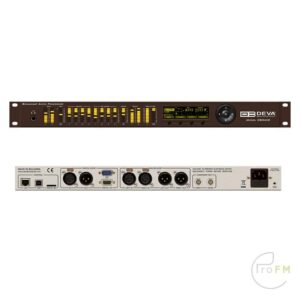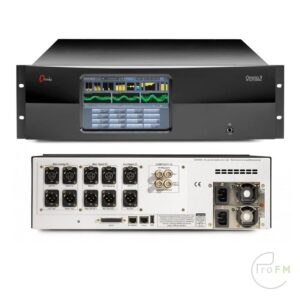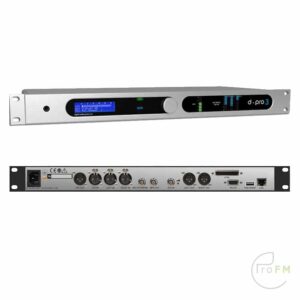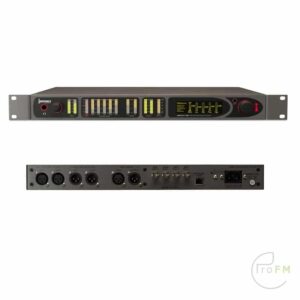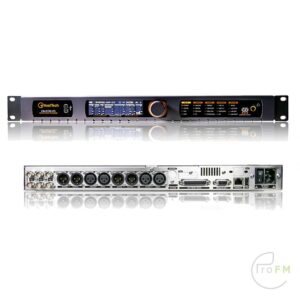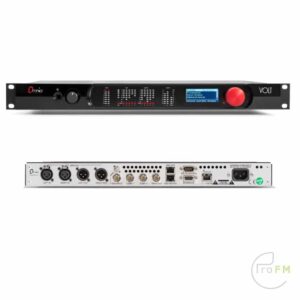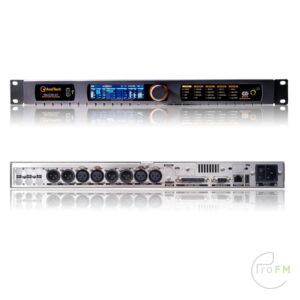Description
Omnia.11 Broadcast Audio Processor
Not just the next step forward in FM processing… the Omnia.11 is the result of a complete re-thinking and re-engineering of all aspects of the modern FM audio processor. From the very beginning, the developers of the Omnia.11 were determined to create a processor which would stand head and shoulders above the legendary Omnia 06. So, Team Omnia started with a fresh canvas.
Everything from the firmware platform, the GUI, to every algorithm was re-thought, and in most cases completely re-engineered or re-designed. The result is unlike any existing product of its kind to date. Omnia.11 has literally defined the new state-of-the-art for FM audio processing, as evidenced by a trifecta of awards from the three leading industry publications: 2010 Cool Stuff Award from Radio World Magazine2010 Pick Hit from Radio Magazine2010 TechInk Award for Innovation by Radio Ink Magazine.
For the first time, listeners will hear the programming, not the processor. Effortlessly loud. Thunderous bottom end, sparkling highs, and crisp, clear voice reproduction. All with that trademark punch and clarity which made Omnia the required audio processor of the highest-rated radio stations in the world.
So dramatic is the advancement of Omnia.11, that initial tests have revealed that many early adopters were genuinely startled by the lack of a traditional “processor sound” when the unit was first deployed. The low level distortion and artifacts, long accepted as part of the fundamentals of processing, are now almost completely gone and certainly not perceptible to the ear.
The firmware in Omnia.11 takes advantage of software capabilities never before possible. The results are dynamics algorithms that were once only a dream of the processing enthusiast. AGCs, Compressors, and Limiters analyze music in real time and adjust internal parameters for optimum performance across a broad range of material.
Available in two models:
Omnia FMHD: Featuring dual, independently controlled processing paths for FM and HD/DRM
Omnia FM: Without HD/DRM capability, but can be upgraded to FMHD at a later date.
Some of the Features:
Newly developed intelligent wideband AGC
Newly refined dynamically
Flat & time aligned crossovers- New dual-topology multiband AGC/Compressor-Limiters using Chameleon Processing Technology
New Density Detector for properly handled hyper-compressed content
New Ultra-LoIMD multiband limiter system with smart gain-reduction technology
New Bass-Management system for unprecedented bass power with no nasty side-effects
New Ultra LoIMD distortion controlled clipper system designed specifically to reduce IM distortion in this critical stage of the processing
Newly refined Integrated laboratory-grade stereo generator with dual composite MPX outputs, 19 kHz reference output, SCA input, >80 dB pilot protection and precision MPX LPF to protect RDS/RBDS and SCA signals, ITU-BS-412 MPX limiter
Newly refined parallel HD processing path with its own final mixer, look-ahead limiter and Sensus technology for HD-1, DAB or Internet stream.
NEW! G-Force™ Dynamics Engine
The G-Force Plug-In (which ships standard on all new Omnia.11 units and can be added as an optional upgrade for existing units in the field) enables Omnia.11 to handle rapidly changing, hyper-compressed source material better than ever with new, sophisticated improvements. The G-Force dynamics processing framework lets the Omnia.11 set the overall EQ for signature consistency, making it sound cleaner, clearer, louder, more consistent, more open, and more pleasing. You hear the music. You hear the voice. You don’t hear the processor.
Solar Plexus
For deep, tight bass that you can feel!
1 Louder
To gain that extra db of loudness.
Intelligent Ultra-Multiband Limiter System
Self-adjusting attack/release functions guarantee crystal clear music and voice. The limiters are self-adapting and can tune themselves to the activity of the AGC section on the fly, providing more powerful and transparent limiter action than possible before. Makes adjustment of limiters a breeze!
Bass Management
Manages harmonics for a natural and undistorted bottom end.
Ultra LoIMD Distortion Controlled Clipper System
Dramatically reduces intermodulation distortion (IMD) for more loudness headroom.
MPX Composite Baseband Over AES (Omnia Direct)
Output of the Omnia.11’s stereo generator can be coupled directly to the modulator of the transmitter’s exciter. This enables the exciter to modulate with more precision and clarity.
Perfect Declipper Plug-In (Optional)
A revolutionary new algorithm to restore clipped segments and remove distortion in aggressively mastered audio recordings results in a clearer, more open texture that also gives more flexibly with processing choices. (Must be running v3.0 and G-Force.)
SSBSC Technology
Omnia.11 Single Sideband Suppressed Carrier (SSBSC) technology may reduce multipath distortion.
Extra Wide Touchscreen
10.5″ diagonal screen clearly shows all controls.
Looks Cool and Stays Cool
Military-grade, fanless industrial design stays cool with heatsinks in rugged chassis.
General:
Non-linear Crosstalk: > -80 dB, main to sub or sub to main channel (referenced to 100% modulation).
38 kHz Suppression: > 70 dB (referenced to 100% modulation).
76 kHz Suppression: > 80 dB (referenced to 100% modulation).
Pilot Protection: > -65 dB relative to 9% pilot injection, ± 1 kHz.
57 kHz (RDS/RBDS) Protection: better than -50 dB.
Connectors:
Two EMI suppressed female BNC, floating over chassis ground
Maximum Load Capacitance: 5nF (at 10 ohms source impedance).
Maximum cable length: 100 feet/30 meters RG-58A/U.
Analog Audio Input:
Left/Right Stereo. Electronically balanced.
Input impedance 10k ohms resistive.
Maximum Input Level: 22 dBu.
Nominal Input Level: 4dBu, which nets a -18dBFS input meterreading on a steady-state signal when the Input Gain controlis set to 0.0dB. Program material with a nominal average level(VU reading) of 4dBu will typically produce peak readings on the input meter in the range of -12 dBFS to -6dBFS. This is the correct operating level.
A/D Conversion:
Crystal Semiconductor CS5361, 24 bit 128x over-sampled delta-sigma converter with linear-phase anti-aliasing filter. Pre-ADCanti-alias filter, with high-pass filter at <10 Hz.
Connectors: Two, EMI-suppressed XLR-female. Pin 1 chassis ground, Pin 2 “Hot.”
Analog Audio Output:
Left/Right Stereo. Electronically balanced.
Output Impedance 20 ohms.
Minimum load Impedance: 600 ohms.
Output Level adjustable from -2 dBu to 22dBu peak in 0.1dB steps.
D/A Conversion:
Crystal Semiconductor CS4391, 24 bit, 128x oversampled.
Connectors: Two, EMI-suppressed XLR-male. Pin 1 chassis ground, Pin 2 “Hot.”
Frequency Response
Complies with the standard 50 or 75 microsecond pre-emphasis curve within ± 0.5 dB, 30 Hz to 15 kHz. The analog left/right output and AES/EBU Digital outputs can be configured for flat or pre- emphasized output.
System Distortion:
Less than 0.01% THD, 20 Hz – 7.5 kHz. Second harmonic distortion above 7.5 kHz is not audible in the FM system.
Signal-Noise Ratio: > -80 dB de-emphasized, 20 Hz – -15 kHz bandwidth, referenced to 100% modulation.
The measured noise floor will depend upon the settings of the Input and Output Gain controls and is primarily governed by dynamic range of the Crystal Semiconductor CS5361 A/D Converter which is specified as >110 dB. The dynamic range of the internal digital signal processing chain is >144 dB.
Stereo Separation:
Greater than 65 dB, 20 Hz – -15 kHz; 70 dB typical.
Crosstalk:
> -70 dB, 20 Hz — 15 kHz.
System Latency:
36ms. “FM” channel, as measured from the analog inputs through the composite MPX output.
Composite Outputs:
Source Impedance: 5 ohms or 75 ohms, jumper-selectable. Single ended and floating over chassis ground. Output Level: 0V to 10V in 0.05V steps, software adjustable.
D/A Conversion:
Texas Instruments/Burr Brown PCM1798, 24-bit sigma-delta converter.
Configuration:
Two electrically independent outputs. Software based level adjustment.
Load Impedance:
50 ohms or greater load is suggested.
Pilot Level:
Adjustable from 4.0% to 12.0% in 0.1% steps and OFF.
Pilot Stability 19 kHz, ± 0.5 Hz.
Signal-to-Noise Ratio:
-85 dB typical, 75 μs de-emphasized, 15 kHz bandwidth, referenced to 100% modulation).
Distortion:
< 0.02% THD 20 Hz – 15 kHz bandwidth, 75 μs de-emphasized, referenced to 100% modulation.
Stereo Separation: > 65 dB, 30 Hz – 15 kHz.
Linear Crosstalk: > -80 dB, main to sub or sub to main channel, referenced to 100% modulation.
Connector:
XLR-female, EMI-suppressed. Pin 1 chassis ground, Pin 2-3 transformer isolated, balanced, and floating. Standard AES3 specified balanced 110 ohm input impedance.
External Sync Range:
Automatically accepts sample rates between 32kHz and 96kHz. Connector: XLR-female, EMI- suppressed. Pin 1 chassis ground, pins 2 and 3 transformer isolated, balanced, and floating – AES3 standard 110 ohm impedance.
Remote Control:
Via Ethernet using built-in Java (TM) based remote control program integrated into web page interface. All software is served from the built-in web server to any standard web browser; there is nothing to install on the user’s computer.
Connectors:
Ethernet – Industry standard EMI-suppressed RJ-45 connector.
GPI Interface:
Connector: EMI suppressed DB-15 female connector.
Power Requirements:
Voltage: 100-250 VAC, 47-63 Hz.
Power Connector:
EMI suppressed IEC male. Detachable 3-wire power cords supplied for US and European use.
Power Supply:
Internal. Overvoltage and short circuit protected.
Digital Audio Input:
Configuration: Stereo per AES/EBU standard, CS8420 Digital Audio Transceiver with 24 bit resolution, software selection of stereo, mono from left, mono from right or mono from sum.
Automatically accepts and locks to input sample rates between 30 and 108 kHz.
Connector: XLR-female, EMI-suppressed. Pin 1 chassis ground, pins 2 and 3 transformer isolated, balanced, and floating – AES3 standard 110 ohm impedance.
Digital Audio Output #1:
Stereo per AES3 standard. Output can be configured in software for flat or pre-emphasized response at 50 or 75 microseconds.
Digital Sample Rates: Output sample rates software selectable for 48kHz, Sync to Input or Sync to External.
Connector: XLR-male, EMI-suppressed. Pin 1 chassis ground, pins 2 and 3 transformer isolated, balanced, and floating. Standard AES3 specified 110 ohm source impedance.
Digital Output Level: -22.0 to 0.0 dBFS software adjustable.
Digital Audio Output #2:
Stereo per AES3 standard. Output can be configured in software for flat pre-emphasized response at 50 or 75 microseconds.
Digital Sample Rates: Output sample rates software selectable for 48kHz, 44.1kHz or Sync to External.
Connector: XLR-male, EMI-suppressed. Pin 1 chassis ground, pins 2 and 3 transformer isolated, balanced, and floating. Standard AES3 specified 110 ohm source impedance.
Digital Output Level: -22.0 to 0.0 dBFS software adjustable.
External Sync Input:
External Sync: Output sample rate can be synchronized to the signal present on the AES/EBU input, or to an AES3 signal applied to the Ext. Sync input connector. (Does not accept Word Clock Inputs)
Regulatory:
North America: FCC and CE tested and compliant, power supply is UL approved.
Europe: Complies with the European Union Directive 2002/95/EC on the restriction of the use of certain hazardous substances in electrical and electronic equipment (RoHS), as amended by Commission Decisions 2005/618/EC, 2005/717/ EC, 2005/747/EC (RoHS Directive), and WEEE.
- Description
-
Omnia.11 Broadcast Audio Processor
Not just the next step forward in FM processing… the Omnia.11 is the result of a complete re-thinking and re-engineering of all aspects of the modern FM audio processor. From the very beginning, the developers of the Omnia.11 were determined to create a processor which would stand head and shoulders above the legendary Omnia 06. So, Team Omnia started with a fresh canvas.
Everything from the firmware platform, the GUI, to every algorithm was re-thought, and in most cases completely re-engineered or re-designed. The result is unlike any existing product of its kind to date. Omnia.11 has literally defined the new state-of-the-art for FM audio processing, as evidenced by a trifecta of awards from the three leading industry publications: 2010 Cool Stuff Award from Radio World Magazine2010 Pick Hit from Radio Magazine2010 TechInk Award for Innovation by Radio Ink Magazine.
For the first time, listeners will hear the programming, not the processor. Effortlessly loud. Thunderous bottom end, sparkling highs, and crisp, clear voice reproduction. All with that trademark punch and clarity which made Omnia the required audio processor of the highest-rated radio stations in the world.
So dramatic is the advancement of Omnia.11, that initial tests have revealed that many early adopters were genuinely startled by the lack of a traditional “processor sound” when the unit was first deployed. The low level distortion and artifacts, long accepted as part of the fundamentals of processing, are now almost completely gone and certainly not perceptible to the ear.
The firmware in Omnia.11 takes advantage of software capabilities never before possible. The results are dynamics algorithms that were once only a dream of the processing enthusiast. AGCs, Compressors, and Limiters analyze music in real time and adjust internal parameters for optimum performance across a broad range of material.
Available in two models:
Omnia FMHD: Featuring dual, independently controlled processing paths for FM and HD/DRM
Omnia FM: Without HD/DRM capability, but can be upgraded to FMHD at a later date.Some of the Features:
Newly developed intelligent wideband AGC
Newly refined dynamically
Flat & time aligned crossovers- New dual-topology multiband AGC/Compressor-Limiters using Chameleon Processing Technology
New Density Detector for properly handled hyper-compressed content
New Ultra-LoIMD multiband limiter system with smart gain-reduction technology
New Bass-Management system for unprecedented bass power with no nasty side-effects
New Ultra LoIMD distortion controlled clipper system designed specifically to reduce IM distortion in this critical stage of the processing
Newly refined Integrated laboratory-grade stereo generator with dual composite MPX outputs, 19 kHz reference output, SCA input, >80 dB pilot protection and precision MPX LPF to protect RDS/RBDS and SCA signals, ITU-BS-412 MPX limiter
Newly refined parallel HD processing path with its own final mixer, look-ahead limiter and Sensus technology for HD-1, DAB or Internet stream.NEW! G-Force™ Dynamics Engine
The G-Force Plug-In (which ships standard on all new Omnia.11 units and can be added as an optional upgrade for existing units in the field) enables Omnia.11 to handle rapidly changing, hyper-compressed source material better than ever with new, sophisticated improvements. The G-Force dynamics processing framework lets the Omnia.11 set the overall EQ for signature consistency, making it sound cleaner, clearer, louder, more consistent, more open, and more pleasing. You hear the music. You hear the voice. You don’t hear the processor.
Solar Plexus
For deep, tight bass that you can feel!
1 Louder
To gain that extra db of loudness.
Intelligent Ultra-Multiband Limiter System
Self-adjusting attack/release functions guarantee crystal clear music and voice. The limiters are self-adapting and can tune themselves to the activity of the AGC section on the fly, providing more powerful and transparent limiter action than possible before. Makes adjustment of limiters a breeze!
Bass Management
Manages harmonics for a natural and undistorted bottom end.
Ultra LoIMD Distortion Controlled Clipper System
Dramatically reduces intermodulation distortion (IMD) for more loudness headroom.
MPX Composite Baseband Over AES (Omnia Direct)
Output of the Omnia.11’s stereo generator can be coupled directly to the modulator of the transmitter’s exciter. This enables the exciter to modulate with more precision and clarity.
Perfect Declipper Plug-In (Optional)
A revolutionary new algorithm to restore clipped segments and remove distortion in aggressively mastered audio recordings results in a clearer, more open texture that also gives more flexibly with processing choices. (Must be running v3.0 and G-Force.)
SSBSC Technology
Omnia.11 Single Sideband Suppressed Carrier (SSBSC) technology may reduce multipath distortion.
Extra Wide Touchscreen
10.5″ diagonal screen clearly shows all controls.
Looks Cool and Stays Cool
Military-grade, fanless industrial design stays cool with heatsinks in rugged chassis.
- Specifications
-
General:
Non-linear Crosstalk: > -80 dB, main to sub or sub to main channel (referenced to 100% modulation).
38 kHz Suppression: > 70 dB (referenced to 100% modulation).
76 kHz Suppression: > 80 dB (referenced to 100% modulation).
Pilot Protection: > -65 dB relative to 9% pilot injection, ± 1 kHz.
57 kHz (RDS/RBDS) Protection: better than -50 dB.Connectors:
Two EMI suppressed female BNC, floating over chassis ground
Maximum Load Capacitance: 5nF (at 10 ohms source impedance).
Maximum cable length: 100 feet/30 meters RG-58A/U.Analog Audio Input:
Left/Right Stereo. Electronically balanced.
Input impedance 10k ohms resistive.
Maximum Input Level: 22 dBu.
Nominal Input Level: 4dBu, which nets a -18dBFS input meterreading on a steady-state signal when the Input Gain controlis set to 0.0dB. Program material with a nominal average level(VU reading) of 4dBu will typically produce peak readings on the input meter in the range of -12 dBFS to -6dBFS. This is the correct operating level.A/D Conversion:
Crystal Semiconductor CS5361, 24 bit 128x over-sampled delta-sigma converter with linear-phase anti-aliasing filter. Pre-ADCanti-alias filter, with high-pass filter at <10 Hz.
Connectors: Two, EMI-suppressed XLR-female. Pin 1 chassis ground, Pin 2 “Hot.”Analog Audio Output:
Left/Right Stereo. Electronically balanced.
Output Impedance 20 ohms.
Minimum load Impedance: 600 ohms.
Output Level adjustable from -2 dBu to 22dBu peak in 0.1dB steps.D/A Conversion:
Crystal Semiconductor CS4391, 24 bit, 128x oversampled.
Connectors: Two, EMI-suppressed XLR-male. Pin 1 chassis ground, Pin 2 “Hot.”
Frequency Response
Complies with the standard 50 or 75 microsecond pre-emphasis curve within ± 0.5 dB, 30 Hz to 15 kHz. The analog left/right output and AES/EBU Digital outputs can be configured for flat or pre- emphasized output.System Distortion:
Less than 0.01% THD, 20 Hz – 7.5 kHz. Second harmonic distortion above 7.5 kHz is not audible in the FM system.
Signal-Noise Ratio: > -80 dB de-emphasized, 20 Hz – -15 kHz bandwidth, referenced to 100% modulation.
The measured noise floor will depend upon the settings of the Input and Output Gain controls and is primarily governed by dynamic range of the Crystal Semiconductor CS5361 A/D Converter which is specified as >110 dB. The dynamic range of the internal digital signal processing chain is >144 dB.Stereo Separation:
Greater than 65 dB, 20 Hz – -15 kHz; 70 dB typical.Crosstalk:
> -70 dB, 20 Hz — 15 kHz.System Latency:
36ms. “FM” channel, as measured from the analog inputs through the composite MPX output.Composite Outputs:
Source Impedance: 5 ohms or 75 ohms, jumper-selectable. Single ended and floating over chassis ground. Output Level: 0V to 10V in 0.05V steps, software adjustable.D/A Conversion:
Texas Instruments/Burr Brown PCM1798, 24-bit sigma-delta converter.Configuration:
Two electrically independent outputs. Software based level adjustment.Load Impedance:
50 ohms or greater load is suggested.Pilot Level:
Adjustable from 4.0% to 12.0% in 0.1% steps and OFF.
Pilot Stability 19 kHz, ± 0.5 Hz.Signal-to-Noise Ratio:
-85 dB typical, 75 μs de-emphasized, 15 kHz bandwidth, referenced to 100% modulation).Distortion:
< 0.02% THD 20 Hz – 15 kHz bandwidth, 75 μs de-emphasized, referenced to 100% modulation.
Stereo Separation: > 65 dB, 30 Hz – 15 kHz.
Linear Crosstalk: > -80 dB, main to sub or sub to main channel, referenced to 100% modulation.Connector:
XLR-female, EMI-suppressed. Pin 1 chassis ground, Pin 2-3 transformer isolated, balanced, and floating. Standard AES3 specified balanced 110 ohm input impedance.External Sync Range:
Automatically accepts sample rates between 32kHz and 96kHz. Connector: XLR-female, EMI- suppressed. Pin 1 chassis ground, pins 2 and 3 transformer isolated, balanced, and floating – AES3 standard 110 ohm impedance.Remote Control:
Via Ethernet using built-in Java (TM) based remote control program integrated into web page interface. All software is served from the built-in web server to any standard web browser; there is nothing to install on the user’s computer.Connectors:
Ethernet – Industry standard EMI-suppressed RJ-45 connector.
GPI Interface:
Connector: EMI suppressed DB-15 female connector.Power Requirements:
Voltage: 100-250 VAC, 47-63 Hz.Power Connector:
EMI suppressed IEC male. Detachable 3-wire power cords supplied for US and European use.Power Supply:
Internal. Overvoltage and short circuit protected.Digital Audio Input:
Configuration: Stereo per AES/EBU standard, CS8420 Digital Audio Transceiver with 24 bit resolution, software selection of stereo, mono from left, mono from right or mono from sum.
Automatically accepts and locks to input sample rates between 30 and 108 kHz.
Connector: XLR-female, EMI-suppressed. Pin 1 chassis ground, pins 2 and 3 transformer isolated, balanced, and floating – AES3 standard 110 ohm impedance.Digital Audio Output #1:
Stereo per AES3 standard. Output can be configured in software for flat or pre-emphasized response at 50 or 75 microseconds.
Digital Sample Rates: Output sample rates software selectable for 48kHz, Sync to Input or Sync to External.
Connector: XLR-male, EMI-suppressed. Pin 1 chassis ground, pins 2 and 3 transformer isolated, balanced, and floating. Standard AES3 specified 110 ohm source impedance.
Digital Output Level: -22.0 to 0.0 dBFS software adjustable.Digital Audio Output #2:
Stereo per AES3 standard. Output can be configured in software for flat pre-emphasized response at 50 or 75 microseconds.
Digital Sample Rates: Output sample rates software selectable for 48kHz, 44.1kHz or Sync to External.
Connector: XLR-male, EMI-suppressed. Pin 1 chassis ground, pins 2 and 3 transformer isolated, balanced, and floating. Standard AES3 specified 110 ohm source impedance.
Digital Output Level: -22.0 to 0.0 dBFS software adjustable.External Sync Input:
External Sync: Output sample rate can be synchronized to the signal present on the AES/EBU input, or to an AES3 signal applied to the Ext. Sync input connector. (Does not accept Word Clock Inputs)Regulatory:
North America: FCC and CE tested and compliant, power supply is UL approved.
Europe: Complies with the European Union Directive 2002/95/EC on the restriction of the use of certain hazardous substances in electrical and electronic equipment (RoHS), as amended by Commission Decisions 2005/618/EC, 2005/717/ EC, 2005/747/EC (RoHS Directive), and WEEE. - Video
-

